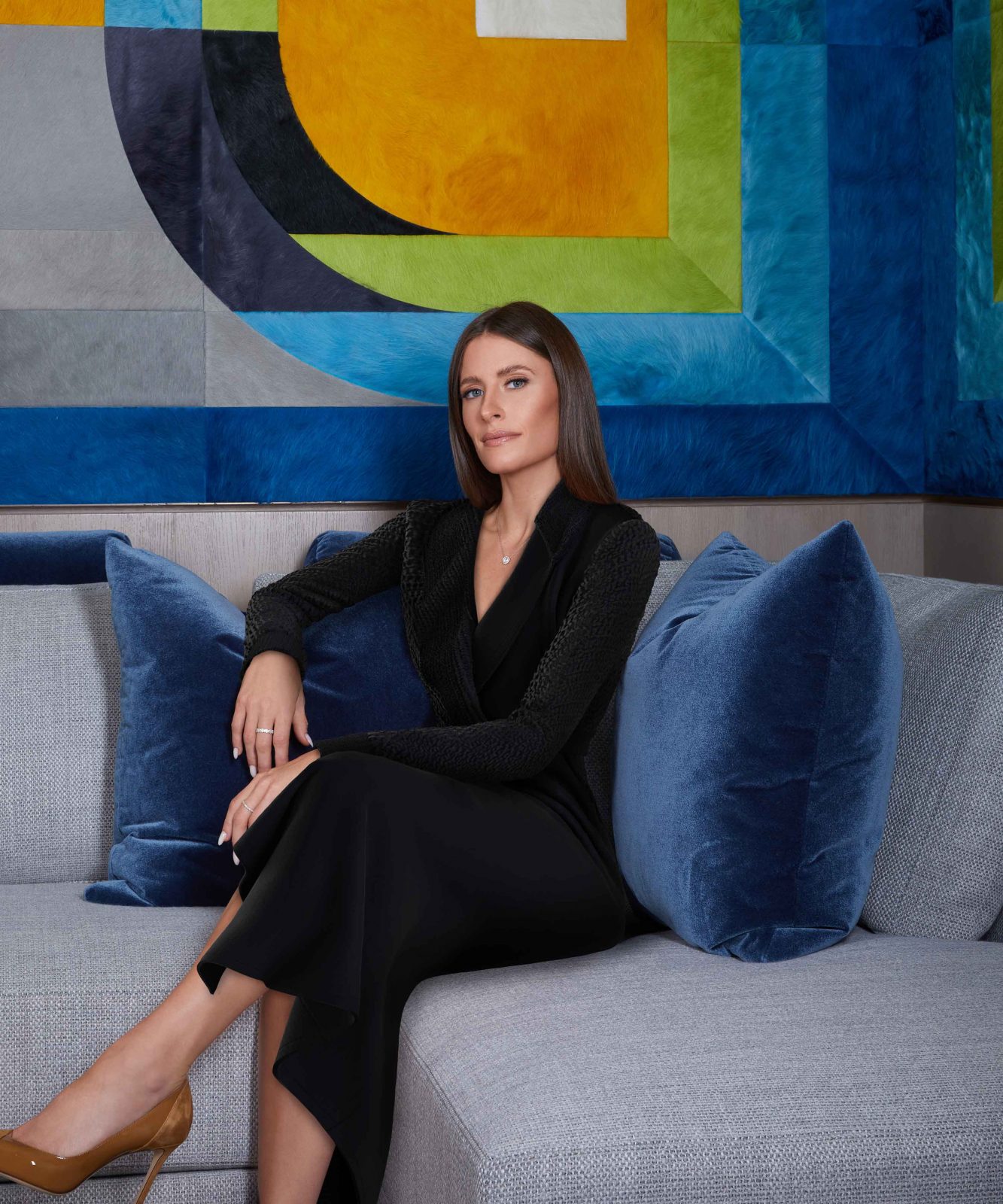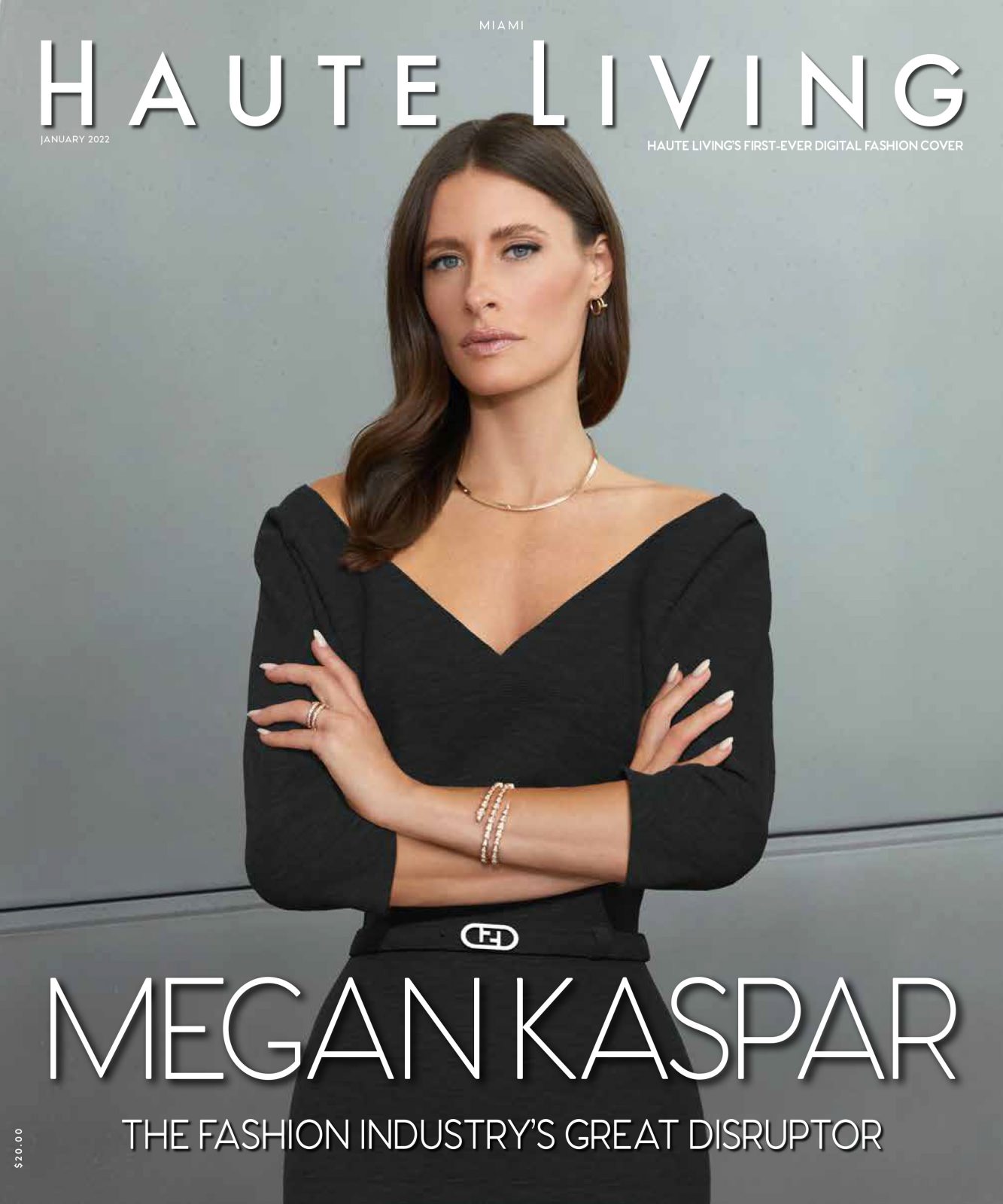
RING (right): Cartier, shop here
RING & BRACELET: Bvlgari, shop here
MEGAN KASPAR IS AT THE HELM OF THE RAPIDLY EVOLVING BLOCKCHAIN INDUSTRY AS ONE OF THE LEADING FEMALES MAKING A MAJOR DIFFERENCE IN THE SPACE THROUGH FASHION.
BY ADRIENNE FAUROTE
PHOTOGRAPHY ALBERTO GONZÁLEZ
HAIR STYLIST MARCO NORMA & VIOLA TAMBURI, ROSSANO FERRETTI
MAKEUP ARTIST CESAR FERRETTE & SIDNEY JAMILA
MANICURIST LISA KON
THIS IS HAUTE LIVING’S FIRST-EVER DIGITAL FASHION COVER; DIGITALLY DRESSED BY DRESSX.
It’s the morning of our interview, and a breaking headline notification reads across my phone screen: “Goodbye, Staples Center. Hello, Crypto.com Arena.” The news would soon be acclaimed as one of the largest naming deals in sports history as Crypto.com paid more than $700 million for the naming rights of the iconic downtown Los Angeles venue in a 20-year deal. A moment where millions across the globe shared the universal sentiment that this new world of crypto is, in fact, here to stay.
Yet, for Megan Kaspar, this news is not shocking; this news is her world. For almost the last decade, Kaspar has been at the forefront of what is now one of the fastest growing global industries. As the cofounder and managing director of Magnetic, a privately held crypto and blockchain investment and incubation firm, she has invested in over 50 early-stage digital assets and blockchain companies — ultimately revealing her unwavering belief that this is not just the future; it is our present and it’s our duty to make an impact.
Stepping into Kaspar’s universe is nothing shy of impressive. Kaspar immediately immerses you into her dynamic world of working 20 steps ahead with the evolution of crypto. Yet, when she first began dabbling in the space, she too had her reservations. “Similar to most people’s initial reaction to the concept of cryptocurrency, when I became aware of bitcoin in 2010, I thought it was a scam,” she says. “It took me two or three years to understand the underlying value of the technology, the power of the network, and the applications of the technology which solve numerous problems. My first ‘aha moment’ was between 2013 and 2014. At that time, fewer cryptocurrency exchanges existed and the trading volume was extremely low. However, I began to see a future where blockchain technology would eventually generate, capture, store, and disseminate all data, and cryptocurrency would provide a replacement to physical fiat — as the world moves towards complete digitalization and dematerialization. Over time it became increasingly obvious to me how this technology could upgrade global capital markets and the financial industry, with an improved, secure technology layer added. And that was when I realized I would be spending the rest of my career in this space.”
While studying for her undergraduate degree, Kaspar worked for a family office focused on biotech. It was there that she got her first glimpse into the industry. “They asked me to explore investment opportunities in emerging technologies outside of their traditional investment focus,” she says. “I was aware of crypto at the time, specifically bitcoin, and I had read the Bitcoin white paper because someone very close to me introduced the concept of bitcoin and the Bitcoin blockchain. They were using it as a form of internet currency to trade and sell in-game items. Gaming was one of the earliest uses of bitcoin.”

SHOES: Christian Louboutin, shop here
NECKLACE, BRACLET, RING (left): Bvlgari, shop here
EARRING & RING (right): Cartier, shop here
Photo Credit: Alberto González

Over the next several years, Kaspar would become closer to the industry, ultimately making a name for herself and creating her own path of discovery. “Around 2015, after the Ethereum crowdsale (a significant milestone in 2014 for the industry), I had a pretty good knowledge base of how the technology works and what the intelligence layer on top of the blockchain meant — in terms of the Ethereum virtual machine,” explains Kaspar. ” Soon after, leading me to the foresight where I was able to imagine a world where our digital items and digital assets—whether in a game or in future augmented reality use cases—could be monetized using smart contracts on a blockchain.”
A brief anecdote about virtual assets: In early October, we sat down virtually with Kaspar, and about 20 minutes into the conversation, she revealed her earrings were actually augmented reality (AR) NFT earrings. And, spoiler alert, they look extremely real as they are programmed to sync with her every move; so, when she shakes her head, the earrings naturally follow her body movement. In fact, in our final interview, she wore an emerging digital designer, Alterrage. Kaspar was the first person to wear augmented reality digital NFT fashion on live television and continues to push beyond the barriers of physical, traditional fashion; thus, for our issue this month, she is wearing only digital attire.
To further understand what exactly it means to own digital items, Kaspar provided a 101 of the buzziest terms in the space right now. Kaspar reveals that understanding the metaverse before you address NFTs (non-fungible tokens) can make the disruptive business models of blockchain technology easier to conceptualize. “This word [metaverse] is proliferating everywhere this year, especially following Facebook’s name change to ‘Meta,'” says Kaspar.
Humans have actually been increasingly living closer in approximation to the metaverse through social media and video communication tools like Zoom. “The metaverse is a digital ecosystem with a virtual economy where users can interact, experience, transact, and generate value together,” explains Kaspar. “I think the most important nuance people tend to not be aware of is the difference between centralized and decentralized metaverse platforms and applications. Web2, the version of the internet most of us are familiar with today, is dominated by companies that are centralized and provide services in exchange for our personal data, such as in Fortnite, Instagram, Youtube, VR Chat. Web3 refers to the decentralized underlying technology and platform infrastructure on blockchains for greater user utility. The ultimate goal of Web3 is to create more intelligent, connected, and open applications and websites. Notable Web3 companies like BitClout, Decentraland, Newlife, and Rally enable users to participate without giving up privacy and personal information on trustless and transparent applications. Web3 metaverses are not carbon copies of the physical world. They have differentiated norms and cultures which continue to evolve, breaking barriers and boundaries that limit our physical world.”
“There’s also meta-commerce,” adds Kaspar. “Simultaneous shifts in culture, technology, and online social interactions are forging a digital economy, empowering content creators while providing new paths to wealth creation. The use of decentralized tools, like NFTs, are driving commercial transactions to Web3 platforms while creating next-generation consumer entertainment experiences.”

SHOES: Jimmy Choo, shop here
EARRINGS, RINGS & NECKALCE: Tiffany & Co. (talent’s personal)
WATCH: Cartier, shop the Tank Must Watch here
Photo Credit: Alberto González
So, what exactly is an NFT? Kaspar breaks it down: “NFTs are smart contracts on a blockchain — which is just a system of recording information in a way that makes it very difficult or impossible to change or hack (depending on the blockchain’s governance), coded with some sort of unique, one-of-a-kind piece of data, information, image, or video. For instance, something so simple as your driver’s license could be made into a NFT. A majority of the NFTs, and all the top NFT collections like Crypto Punks, ArtBlocks, VeeFriends and the most recent community trend, a Takashi Murakami collab, RTFTK CloneXs live on the Ethereum blockchain. Though, other blockchain NFT ecosystems like Solana and Avalanche are growing.”
And while each industry, from art to finance, approaches NFTs differently, there’s one sector Kaspar is dominating: fashion.
The fashion industry generates $2.5 trillion dollars in global annual revenue (pre-pandemic), and the beauty industry averages around $5 billion a year. Through Web3’s meta-commerce, Kaspar believes that new product channels and business models hold the potential of at least doubling global fashion and beauty revenues over the next two decades— just as Web2 supported the emergence of e-commerce (think Instagram shopping capabilities).
For Kaspar, this is just the beginning of fashion’s existence and disruption within the space. “A lurking opportunity is emerging from the blockchain ecosystem, and it is massive. Overlooked by most, the dematerialization and digitalization of fashion is a sleeping giant mega-trend, with the greatest potential for global economic disruption and positive environmental impact, next to financial infrastructure.”

EARRINGS & NECKLACE: Cartier, shop here
RINGS & BRACELET: Bvlgari, shop here
Photo Credit: Alberto González
“We are in the early days of understanding the scale of the digital fashion economy opportunity,” says Kaspar. “The luxury sector of the fashion industry was slow to adapt to shifts to e-commerce and social media. But the current metaverse trend of high-end house name brands like Balenciaga, D&G, Gucci, Burberry, and Ralph Lauren have launched AR try-on capabilities, digital items collaborations, and virtual activations. However, most brands still do not fully understand the power of wearable digital fashion and the full range of features that NFTs can provide. It will become increasingly more obvious to brands that NFT fashion opportunities are not just a one-off marketing channel but a product channel providing newfound revenue streams.”
This new disruption Kaspar speaks of goes beyond the typical digital realm. It spans product design, production and real-time customization, marketing, customer acquisition and retention, sale and product use, or wearability functions.
Most millennials, Gen Z’s, and Generation Alpha’s already live fully immersed in online vanity and naturally discover luxury brands through the centralized version of the metaverse like Fortnite, Roblox, IG and Snapchat. “Fashion is a part of a person’s physical identity, and naturally a part of their digital identity. Many brands, like Gucci, have already released digital apparel inside of centralized games,” says Kaspar. In 2019, Fortnite, which has a free-to-play business model, generated over $3.7 billion in global revenues from the sales of in-game digital apparel. One could argue that Fortnite is a larger apparel company than several popular luxury brands, as it generates higher annual revenue currently above Prada, Burberry, Valentino, and Versace.”
Kaspar first discovered her passion for the fashion industry when dial-up internet emerged in the late ’90s. Growing up in a small town in the Midwest, the internet became her gateway. “I grew up loving high-end fashion,” she says. “I discovered brands like Louis Vuitton through the internet (years later, in 2019, Louis Vuitton became the first major brand to launch an in-game digital clothing collaboration). There are so many cross-over paths between fashion and tech in my life.” In fact, in her senior year of high school, she was voted most fashionable.

RING (right) & EARRINGS: Cartier, shop here
RING & BRACELET: Bvlgari, shop here
Photo Credit: Alberto González
For Kaspar, one of the most exciting aspects of this movement is the democratization of the fashion industry, giving anyone access to a once-exclusive industry. “Imagine an aspiring designer or artist in Ghana with access to a device and wifi; they don’t actually need access to startup capital anymore to be involved in fashion,” explains Kaspar. “They can digitally create 3D fashion garments all through an app and launch their fashion items in augmented reality where people can buy and use them. Apps like FLYP provide these services along with single item on-demand manufacturing and drop shipping.
“Anyone can technically design a clothing line with these capabilities,” she says. “This empowers a large span of our population. Similar to how Web2 gave me access into the world of high-end, luxury fashion, now we have Web3 that will give people access to fashion in a way that wasn’t possible — and that is such a beautiful thing.”
But, that’s just one way the fashion industry can participate in the shift.
Other major factors like reducing carbon emissions play a significant role. “While I am excited about the upside potential from the fashion industry, there’s a large ESG and social responsibility at play,” explains Kaspar. The fashion industry is undeniably one of the most polluting industries globally, making up 10 percent of our carbon footprint in global emissions, which is more than all international flights and maritime shipping combined. So, evolving into the digital with dematerialization as a trend is beyond impactful.
“The intersection of digital fashion with the traditional fashion industry offers an opportunity to reduce the carbon footprint — starting from the transition to digital samples and 3D try-ons to creating entirely digital collections and metaverse-native fashion shows (like the first ever digital Fashion Week coming up this March in Decentraland by UNXD) to the process of manufacturing, distributing, selling, and using fashion and apparel. Digital fashion offers existing brands an opportunity to participate in meta-commerce while improving their impact on the environment. By focusing more on digital product lines, many of these environmentally harmful practices will disappear,” she adds.
As a society, we are transitioning from a 2D “heads down” to a 3D “heads up” digital reality that is both immersive and experiential. “This technological shift will have a profound effect on the fashion, retail, and beauty industries through the dematerialization of products, everything from clothing, shoes, handbags, accessories, and even beauty and makeup,” says Kaspar. “It is said that 40 percent of the Western closet goes unworn. An infinite amount of digital clothing and accessories can exist without negatively impacting our planet.”
There are also new, competitive drivers being put into play. “One disrupting feature of digitizing luxury fashion is the ability to use items as collateral on the blockchain,” she says. “Also, an NFT gaming concept called play-to-earn has generated newfound value for users. In fashion, we’re going to see brands adopting wear-to-earn and own-to-earn model as marketing and sponsorship strategies that influencers can utilize to incentivize consumers to wear the digital items.” This new model will rely on Augmented Reality (AR) technology in traditional and social media.
“Today, nascent versions of AR digitals are available, such as digital tailoring as a service, AR try-on, and direct purchasing functions and in-platform live wearables. Social media content creators and brands are beginning to understand the use case for AR wearables. For instance, fashion brands no longer need to ship physical products to influencers or on-shoot locations,” says Kaspar.
She’s right. For our cover shoot, we made history. Gone are the days of shipping over 20 trunks of clothing across the globe. On our cover shoot, Kaspar wore a tightly fitted, all-black outfit from Kim Kardashian’s Skims collection in order for the images to be digitally clothed. “Kim’s Skims line is perfect for metaverse digital fashion to be superimposed, layered on top. Whether it is worn for a photoshoot, video shoot or in daily life to superimpose digital 2D or 3D fashion, the near-skin line is ideal. Historically, Kardashian has been on the leading edge of fashion, so there was no surprise to me when I discovered her Skims line as a perfect fit for imposed augmented and digital fashion.” says Kaspar.

SHOES: Manolo Blahnik
EARRINGS: Dolce & Gabbana
NECKLACE & BRACELET: Bvlgari, shop here
Photo Credit: Alberto González

DRESSX digitally dressed Kaspar in Fendi, by digitizing selected looks and tailor overlaying the digital clothing on each photo. The process was extremely streamlined and set a precedent for new industry standards. “DRESSX is the world’s largest digital fashion shop, targeting Gen Z and millennials who demand a new shopping solution —digital and sustainable. I see them as the Net-a-porter of the metaverse. The platform provides digital tailoring as a service and a metacloset of digital-only apparel and accessories, which are AR NFT wearables.” Kaspar explains. DRESSX digital fashion has been featured in Vogue Singapore, Vogue Business, WWD, Forbes, Financial Times and Yahoo! Finance. Kaspar continued, “The founders, Natalia Modenova and Daria Shapovalova, are a powerful force of nature. In just a little over one year the female-led, female-founded metafashion company is the leader of AR try-ons and NFT wearables.”
The cover itself symbolized an industry transformative in the way brands can market fashion and further explore the marketing opportunities, from real-time AR try-on to purchase the item or to create content to an all-digital QR code to instantly access the item and the further brand discovery.
The opportunity is limitless. “I can easily foresee the fashion industry doubling in size over the next 20 years, and it has the potential to go way beyond that in digital. Beyond the new, disruptive marketing and product channels, consumers will be afforded the opportunity to have many multiples more of fashion items in a digital closet and the ability to change them constantly,” says Kaspar.
Kaspar is a founding member of Red DAO, the first-ever fashion-focused DAO, to participate and invest in emerging opportunities around the fashion and beauty space. A DAO, or decentralized autonomous organizations, is a new way to form corporate structure on a blockchain which provides a myriad of attributes traditional business structures cannot. DAO’s are hive-mind-like in structure, where all members contribute and decisions are made based on voting which in Red DAO’s case is weighted according to each member’s capital contribution. Kaspar shares, “the structure can be used similar to how we formed Red DAO, or for a single purpose, like buying a baseball team. Personally, I prefer the DAO structure for three reasons, but the most important being complete, transparent corporate onchain financials and governance. The fact that all company activity, such as changes to company bylaws or investment decisions, are voted on, executed and recorded on a blockchain provides a trustless environment while mitigating potential bad-acting shareholders from unscrupulous activity. 2022 could easily be the year of the DAO in the crypto sector.”

SHOES: Jimmy Choo, shop here
EARRINGS, RINGS & NECKALCE: Tiffany & Co. (talent’s personal)
Photo Credit: Alberto González
In fact, Red DAO is responsible for the most expensive sale of a fashion NFT to date, which was the one of Dolce & Gabbana Doge Crown from UNXD. Red DAO purchased for 423.5 wETH (worth $1.8m at the current price of ETH), which marked a symbolic shift signaling market space for high-end luxury fashion in the metaverse.
Dolce & Gabbana’s Collezione Genesi was the world’s first couture NFT drop by a luxury brand, which incorporated a multi-pronged offering: the physical fashion tethered to a digital version and digital-only fashion, both providing experiences including exclusive access to private couture events in Italy, a private tour of the Dolce & Gabbana atelier, and two-week exhibitions in multiple stores where the collector’s name was displayed. Red DAO purchased three of the nine couture NFT items to participate in the historical moment of a luxury fashion brand’s shift into the Web3 fashion economy.
“The fashion industry is reinventing itself, entering a new era in luxury fashion which is immersive, interactive, and experiential. New projects utilizing these attributes and building commercial applications in the metaverse reach out to Red DAO daily,” admits Kaspar. “We are ecstatic to be in the center vortex of the digital fashion economy revolution, including supporting emerging digital fashion designers like Charlie Cohen, Stephy Fung, Max Salzborn, and Ravi Singh.“
The fashion industry’s potential in this space is bigger than we can ever imagine, presenting an enormous future of opportunity. “It is hard to overstate the impact that wearable NFTs will have on the fashion industry and the world in this decade. This presents a tremendous opportunity for innovators in the retail and fashion industries. The next generation of fashion entrepreneurs will have a digital-first perspective. Wearable, digitally augmented fashion NFTs will be at the forefront. The pay-off here is not just from the infinite design possibilities by removing physical world limitations in the manufacturing process.”
We can expect new digital fashion platforms and luxury marketplaces like DRESSX and UNXD to continue to arise, which are built on or are leveraging blockchain technology, offering digital merchandise that can’t be copied or counterfeited, yet can be instantly traded to anyone in vast global secondary markets with verifiable provenance and ownership.
And, Kaspar is calling it now: the big “gateway” push will come about through wearable augmented reality, facilitated by near-eye wearable devices. “It is highly probable that within the next five years, the mass consumer market will be introduced to these devices, enabling the use of augmented reality in our daily lives. Billions of consumers will migrate from smartphones and tablets into wearable technology like glasses. When that moment arrives, we move from a “heads down” society to a “heads up,” and the digital fashion economy boom with broader and greater applications in social media and social reality is born,” says Kaspar.

Photo Credit: Alberto González
It’s no secret that this world is hard to wrap your brain around, but we are living in a world where technology is advancing at an unprecedented rate. “As we advance globally towards a highly device-driven society, it will become increasingly important for iconic brands to successfully navigate Web3 and appeal to future generations. Kids spend more time in digital worlds than the physical, engaging countless hours perfecting in-game looks on their avatar to impress their classmates online,” Kaspar said after joking about how our kids, their kids, and so on will laugh at our smartphones. “In contrast, they will spend entire afternoons after lunch oblivious to wearing food-stained clothing in front of these same classmates. Brands that understand and deliver products catered to the younger generations’ desire to personalize their digital appearance will survive the disruption of meta-commerce business models.”
As Kaspar remains at the forefront of this movement, she’s learned a precious lesson that has catapulted her career: “I learned that being curious was very profitable. I learned you should not dismiss information given to you, no matter what the source. On a regular occurrence I hear people say they believe they’re too late and they should have invested in the space two years ago or whenever they were first made aware of the crypto asset class. But that is the common mindset most people have, when they hear something that doesn’t resonate with their immediate belief system — they dismiss it. And by dismissing things, you can lose out on opportunities.”
Staying curious with a neutral mindset has opened doors for Kaspar she never knew existed. Today, Kaspar is paving the way for generations of females in the industry, shattering any glass ceiling that gets in her way. “For years, I have worked in a male-dominated industry, but now I am working alongside some of the most high-quality, intelligent women from all over the world that are participating in the space. The merge of fashion and blockchain has made this possible, and that motivates me to continue contributing in the excitement emerging in metafashion.”
To be at the helm of an industry that operates in a realm beyond the normal and at a rapid rate, Kaspar finds ways to stay grounded through daily meditation, nature walks, and reminders to self what the core principles of blockchain has always been about. “The ethos of the blockchain is this open, decentralized world, and it’s the new paradigm; whereas the old generational paradigm is a grinding, competitive space with less opportunity and jealousy galore. The blockchain world is a vast, free open environment where everyone has the opportunity to create and generate value for themselves in a supportive ecosystem. And we’re in the very beginning, early stages of that — it’s still extremely small. The size of the entire asset class, just slightly over $2 trillion with the possibility of achieving tens of multiples greater, keeps me motivated and hopefully for a positive and inclusive future for all. I keep a focused North Star on a deep connection to the ethos of blockchain technology, where everyone’s lives can be enriched through the reach and broader access to empowerment.”

EARRINGS & NECKLACE: Cartier, shop here
RINGS & BRACELET: Bvlgari, shop here
Photo Credit: Alberto González
























